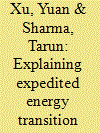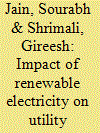|
|
|
Sort Order |
|
|
|
Items / Page
|
|
|
|
|
|
|
| Srl | Item |
| 1 |
ID:
125410


|
|
|
|
|
| Publication |
2013.
|
| Summary/Abstract |
Wind power generation and its impacts on electricity prices has strongly increased in the EU. Therefore, appropriate mark-to-market evaluation of new investments in wind power and energy storage plants should consider the fluctuant generation of wind power and uncertain electricity prices, which are affected by wind power feed-in (WPF). To gain the input data for WPF and electricity prices, simulation models, such as econometric models, can serve as a data basis.
This paper describes a combined modeling approach for the simulation of WPF series and electricity prices considering the impacts of WPF on prices based on an autoregressive approach. Thereby WPF series are firstly simulated for each hour of the year and integrated in the electricity price model to generate an hourly resolved price series for a year. The model results demonstrate that the WPF model delivers satisfying WPF series and that the extended electricity price model considering WPF leads to a significant improvement of the electricity price simulation compared to a model version without WPF effects. As the simulated series of WPF and electricity prices also contain the correlation between both series, market evaluation of wind power technologies can be accurately done based on these series.
|
|
|
|
|
|
|
|
|
|
|
|
|
|
|
|
| 2 |
ID:
166735


|
|
|
|
|
| Summary/Abstract |
Our paper investigates the effect of wind and utility-scale solar electricity generation on wholesale electricity prices in Australia over 2010–2018. We use both high frequency (30-min) and daily datasets for the Australian National Electricity Market (NEM). We estimate autoregressive distributed lag models (ARDL) to decompose the merit order effect of wind and utility-scale solar PV generation over time and across states. We find that an extra GW of dispatched wind capacity decreases the wholesale electricity price by 11 AUD/MWh at the time of generation, while solar capacity by 14 AUD/MWh. The daily merit order effect is lower. We show that the wind merit order effect has been increasing as a function of dispatched wind capacity over time. Despite of this, wholesale electricity prices in Australia have been increasing, predominantly driven by the increase in natural gas prices. Our findings further strengthen the evidence of the merit order effect of renewable energy sources, with important implications for the current energy policy debate in Australia.
|
|
|
|
|
|
|
|
|
|
|
|
|
|
|
|
| 3 |
ID:
185720


|
|
|
|
|
| Summary/Abstract |
Energy transition toward renewables, mainly wind and solar, has gained momentum in the past decade. Although the COVID-19 pandemic brought unprecedented, multi-faceted challenges and uncertainties, India witnessed an expedited energy transition in 2020. With our newly constructed Electric System Dispatch Model for India (ESDMI), this study aims to provide an explanation of the underlining mechanisms. The Janta Curfew (7am-9pm) in India was observed on March 22, 2020 followed by a 21-day complete lockdown starting March 25, 2020 to control the spread of the virus. Electricity demand in India dropped by nearly a quarter. We model the supply-side dynamics prior to and during the pandemic response as well as in a counterfactual scenario in the pandemic's absence. We find that the expedited energy transition could be explained by (i) the higher priority of a large renewables fleet to access electric grid either through stipulations and the merit order effect, and (ii) coal-fired electricity generation is less flexible than natural gas and hydropower units. A substantial amount of coal-fired power plants in India are still far from reaching their designed lifetimes. Their low resilience in such crises could exacerbate the problem of stranded assets.
|
|
|
|
|
|
|
|
|
|
|
|
|
|
|
|
| 4 |
ID:
163569


|
|
|
|
|
| Summary/Abstract |
This paper provides estimates of quantile regression models of the relationship between Italian day-ahead electricity prices, the supply of renewables and the inception of a new cable (SAPEI, linking Sardinia with the Italian peninsula), in the 2006–2015 time window. The results confirm the merit order effects detected in the existing literature, both for photovoltaics and wind power, more strongly in market conditions characterised by moderately low price levels and with some implied increase in volatility. The new cable has apparently challenged the ability of power generating companies to extract value through price spikes, has mitigated volatility, and its effects have been complementary with those of renewables. Effects from photovoltaics are more sensitive to robustness checks. Differences across zonal markets are nonetheless detected.
|
|
|
|
|
|
|
|
|
|
|
|
|
|
|
|
| 5 |
ID:
186486


|
|
|
|
|
| Summary/Abstract |
Declining levelized costs of renewable energy have become a driving force in supporting renewable energy in India; the levelized cost of wind and solar has plummeted to between 3.3¢/kWh and 4¢/kWh. However, limited research exists on the impacts of renewables on the finances of Indian distribution utilities. The present study examines the financial impact of incremental penetration of the hydro, solar, and wind alternative in the generation mix of the distribution company of the Indian state of Madhya Pradesh. Using real-time 15-min interval data and a merit-order-dispatch model, the study quantifies the merit-order-effect and assess the potential savings from renewables. The results indicate that depending upon the penetration level under demand growth cases, renewable integration could lower the power purchase cost of Indian utilities by up to 11%. Wind produces most savings between 0.11¢/kWh and 2.71¢/kWh followed by solar −0.17¢/kWh and 2.56¢/kWh and hydro −0.32¢/kWh and 2.05¢/kWh. The savings will increase with rising electricity demand and plummeting costs of renewables. Integrating moderate levels of renewables no longer presents economic-environment trade-offs and can simultaneously meet multiple policy goals of energy affordability and environmental sustainability.
|
|
|
|
|
|
|
|
|
|
|
|
|
|
|
|
| 6 |
ID:
132655


|
|
|
|
|
| Publication |
2014.
|
| Summary/Abstract |
Renewable energy promotion and its cost are at the heart of the energy policy debate in many countries. The question from an economic perspective is how expensive the promotion of renewable sources through price-based incentive schemes is. This paper addresses this issue empirically. We analyze the Spanish electricity market during the period 2008-2012, where renewable energy production rose by 57%. To determine how expensive it was, we first measure the savings due to the spot price reduction driven by the merit order effect and, second, we compute the amount paid as incentives to green energy by the electricity system; the difference between the two is the net cost of green energy to the electricity markets. We present aggregate results for renewable sources as a whole, as well as individual results for each technology. We show that at the initial stages, when renewable capacity was low, green energy promotion paid for itself (2008-2009); however, from 2010 on, when renewable production reached a relatively high level, it started to impose a positive net cost on the system. Finally, we found substantial differences among technologies: wind energy implied the lowest net cost, while solar photovoltaic was the most expensive.
|
|
|
|
|
|
|
|
|
|
|
|
|
|
|
|
| 7 |
ID:
122711


|
|
|
|
|
| Publication |
2013.
|
| Summary/Abstract |
In electricity markets that use a merit order dispatch system, generation capacity is ranked by the price that it is bid into the market. Demand is then met by dispatching electricity according to this rank, from the lowest to the highest bid. The last capacity dispatched sets the price received by all generation, ensuring the lowest cost provision of electricity. A consequence of this system is that significant deployments of low marginal cost electricity generators, including renewables, can reduce the spot price of electricity. In Australia, this prospect has been recognized in concern expressed by some coal-fired generators that delivering too much renewable generation would reduce wholesale electricity prices. In this analysis we calculate the likely reduction of wholesale prices through this merit order effect on the Australian National Electricity Market. We calculate that for 5 GW of capacity, comparable to the present per capita installation of photovoltaics in Germany, the reduction in wholesale prices would have been worth in excess of A$1.8 billion over 2009 and 2010, all other factors being equal. We explore the implications of our findings for feed-in tariff policies, and find that they could deliver savings to consumers, contrary to prevailing criticisms that they are a regressive form of taxation.
|
|
|
|
|
|
|
|
|
|
|
|
|
|
|
|
| 8 |
ID:
125576


|
|
|
|
|
| Publication |
2013.
|
| Summary/Abstract |
This study investigates the merit order effect (MOE) of the recent years' implementation of solar power in Germany. Market clearing electricity prices and production levels are compared for the years 2009-2011, and a model for the relationship between the electricity price and price sensitive electricity production is developed and applied to predict electricity prices in Germany from July 2010 to July 2011 with and without solar electricity generation (SEG). The results show that the SEG has caused a 7% reduction in average electricity prices for this period. The average daily maximum price and daily price variation are also found to decrease, by 13% and 23%, respectively. When taking the MOE into account the net consumer's cost of the solar feed-in tariff (FIT) system is found to be 23% less than the charge listed in the electricity bill. The German FIT policy for solar power has been subject to considerable public debate, and a common argument brought up in disfavor of the system is the high cost for the consumers. In this study we demonstrate the importance of including the MOE when evaluating the total costs and benefits of the FIT policy mechanism.
|
|
|
|
|
|
|
|
|
|
|
|
|
|
|
|
| 9 |
ID:
112240


|
|
|
|
|
| Publication |
2012.
|
| Summary/Abstract |
Variable renewable energy (VRE) generation from wind and sun is growing quickly in Europe. Already today, VRE's power contribution is at times close to the total demand in some regions with severe consequences for the remainder of the power system. Grid extensions are necessary for the physical integration of VRE, i.e., for power transports, but they also have important economic consequences for all power system participants.
We employ a regional, power system model to examine the role of grid extensions for the market effects of VRE in Europe. We derive cost-optimal macroscopic transmission grid extensions for the projected wind and solar capacities in Europe in 2020 and characterize their effects on the power system with high regional and technological resolution.
Without grid extensions, lower electricity prices, new price dynamics and reduced full load hours for conventional generation technologies result in proximity to high VRE capacities. This leads to substantial changes in the projected achievable revenues of utilities. Grid extensions partially alleviate and redistribute these effects, mainly for the benefit of baseload and the VRE technologies themselves.
|
|
|
|
|
|
|
|
|
|
|
|
|
|
|
|
|
|
|
|
|